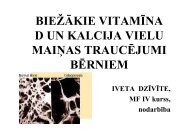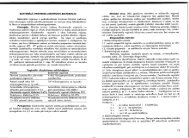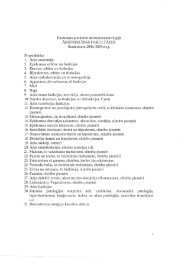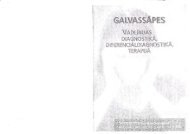PHYSICS
n - susliks.lv
n - susliks.lv
- No tags were found...
You also want an ePaper? Increase the reach of your titles
YUMPU automatically turns print PDFs into web optimized ePapers that Google loves.
due to extensive skin folds, and high hematocrit and erythrocyte<br />
concentrations. Thus the capacity of the frog for transporting<br />
oxygen is substantially increased.<br />
Mules are used at Aucanquilcha, a base camp for the International<br />
High Altitude Expedition, as a transport means in the<br />
5250 - 6000 m altitude range. The animals demonstrate the ability<br />
to accurately assess their capacity for work and refuse to be<br />
pushed beyond a safe limit. Other animals at high altitudes are the<br />
vicuna (5000 - 6000 m), domestic sheep (up to 5250 m), and<br />
horses (up to 4600 m). Birds, however, hold the high altitude records:<br />
condors (7600 m), geese (8534 rn), chough (9000 m) and<br />
griffon vulture (11278 m).<br />
6.1.8. Effects of Altitude on the Plants<br />
6.1. Typical values for diffusion coefficients of small molecules<br />
in aqueous solutions and air (Nobel, 1983)<br />
Substance<br />
Diffusion coefficient,<br />
m 2.s -t<br />
Substance<br />
Diffusion coefficient,<br />
m 2·s-1<br />
Glucose 0.67. 10 9 CO 2 (solution) 1.7 . 10- 9<br />
Ca-+ (with Cl ) 1.2 . 10- 9 CO 2 (gas) 1.5 . 10- 5<br />
K+(with Cl ) 1.9. 10- 9 H 2O 2.4 . 10- 5<br />
Na+ (with Cl ) 1.5 . 10- 9 O 2 1.9 . 10- 5<br />
solution at the right is higher than at the left. It would be<br />
necessary to apply additional pressure by way of a piston (fig. 6.3)<br />
to compensate the pressure difference. The pressure required to<br />
ap -+<br />
Altitudinal variation of climate induces morphological and<br />
physiological changes in plants and their canopy architecture.<br />
Often the plants maintain a compact or dwarf form with small,<br />
narrow or densely pubescent leaves. The ecological zone between<br />
3230 and 3660 m is called an alpine area. Here it is possible to<br />
find considerable changes in quantitative and qualitative characteristics<br />
of the fauna. In addition, there are certain changes in climatic<br />
conditions that are related to the effects of pressure, wind,<br />
humidity and preci pitation, temperature, radiation and gas exchange,<br />
which in turn, also modify the fauna.<br />
6.1.9. Osmotic Pressure<br />
abc<br />
Fig. 6.3. An ideally semipermeable membrane, which separates<br />
two solutions of different concentrations<br />
balance the osmotic flow of water is called the osmotic pressure.<br />
For dilute solutions, osmotic pressure (Posm) obeys the Van't Hoff<br />
relation:<br />
Posm = RTC A<br />
(6.5)<br />
where R is the gas constant (R = 8,31 J·mo)-'·K-I), T the absolute<br />
temperature, and C A<br />
the molar concentration.<br />
6.1.10. Osmotic Phenomena in Plants<br />
The process of osmosis can be considered as a special case of<br />
membrane diffusion in which only the solvent (water) moves<br />
across the membrane (via water channels), while the solute molecules<br />
are restrained by the membrane, which is therefore described<br />
as semipermeable. Typical values for diffusion coefficients<br />
are presented in Table 6.1.<br />
If two solutions with different concentrations are separated by<br />
a membrane (M), the concentration of solution II exceeds that<br />
concentration of solution I, and they are separated by a semi per<br />
meable membrane that allows the passage of water but not the<br />
Most animals are characterized with constant osmotic pressure<br />
which is maintained by the blood. Plant cells, in contrast, exist in<br />
a dilute aqueous environment. Osmosis in plant cells result the<br />
solute, there is a flow of water from left to right and the level of<br />
transfer of solvent molecules from regions of high concentration<br />
48 49






